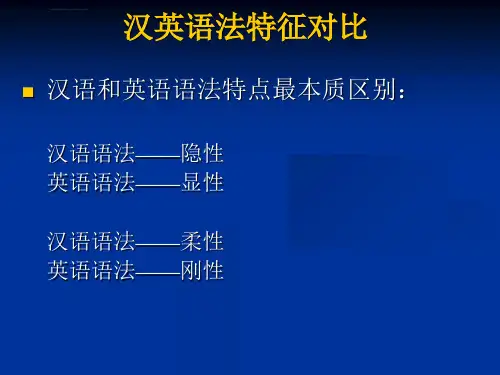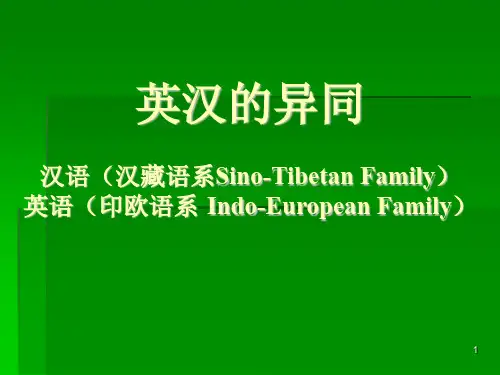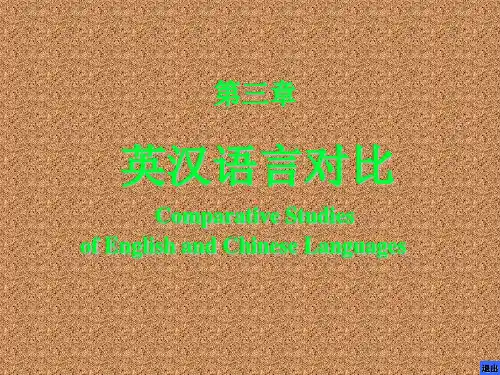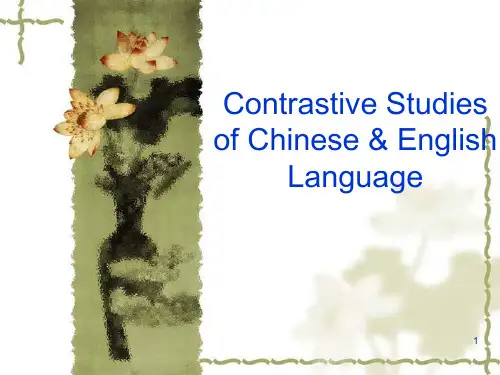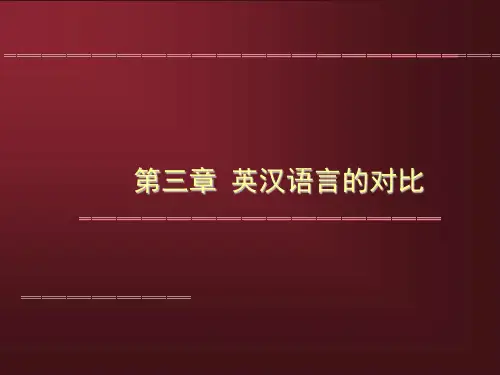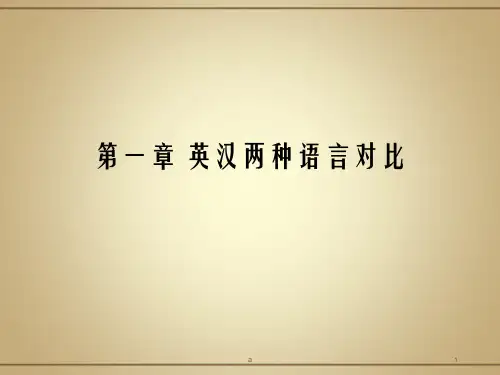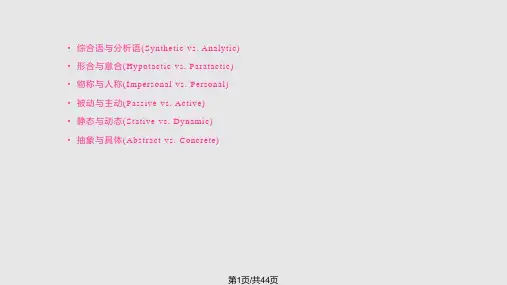- 1、下载文档前请自行甄别文档内容的完整性,平台不提供额外的编辑、内容补充、找答案等附加服务。
- 2、"仅部分预览"的文档,不可在线预览部分如存在完整性等问题,可反馈申请退款(可完整预览的文档不适用该条件!)。
- 3、如文档侵犯您的权益,请联系客服反馈,我们会尽快为您处理(人工客服工作时间:9:00-18:30)。
• As Chinese does not have the grammatical
category of tense, the temporal notions
indicated by English tenses are lexicalized in
Chinese. The lexical words used are mainly adverbs like 那时,昨天,上周,去年,etc., sometimes together with 曾经,过etc. to indicate the past tense; 明天,下周,明年, 要etc. to indicate future tense; 已经,一直 etc. to signal perfect tense. For example:
5. Mood in English and Chinese
• Mood in English • 1) subjunctive mood suggesting doubt,
condition, or a situation contrary to the fact is realized by resorting to auxiliaries with the conjugation of verbs in sentences. Eg. • A. if I were you, I would apply for the job. • B. If I had finished my homework earlier, I would have gone with you to the theatre.
• Derivational morphology is concerned with morphological variations a means of wordbuilding.
2.Morphological contrastive study
• Contrastive analysis on the level of inflectional morphology is largely a matter of constrasting the devices different languages employ to transmit grammatical meanings. These devices are usually known as “grammatical categories”, which include aspect, tense, case, gender, mood, person, class of word(parts of speech)
• Actor
actress
• Waiter waitress
• Host
hostess
• Hero
heroine
• While in Chinese, there is no such suffix to denote gender. Often the prefix ‘男’or ‘女’ is added to show masculine or feminine.
• I’m going to go shopping. • (5)他明早会演奏这支曲子。
• He will be playing the tone tomorrow morning. • (6)他已经得了三次一等奖。
• He has already won the first prize for three times. • (7)五岁以来,他一直在学钢琴。
• E. I wish that he could come.
• 2) mood of advice, permission, necessity, guessing, possibility, prediction, request, condition and oblige is expressed by using the modal verbs like may, might, can, could, should, would, must, ought to…….eg.
• A. The hunters have been lost for days. They could starve!
• B. May I have a look at your pictures? • C. When going by airplane, you should arrive at
• Morphology comprises two parts: inflectional morphology and derivational morphology.
• Inflectional morphology is concerned with morphological variations that result from grammatical needs.
• He has been learning piano since she was five.
3. Case in Eere are nominative case like I, we, you, he, they, objective case like me, us, you, her, him, and possessive case like my, our, your, her, his and their and nominal pronoun like mine, ours, yours, hers, his, and theirs. While in Chinese, there is no such inflection of case pronoun. It is the word order that determines if a noun or noun phrases is the nominative case or the objective case or possessive case. Eg.:
4. Gender in English and Chinese
• Generally speaking, both English and Chinese don’t have word inflections indicating particular masculine or feminine of a thing. However, a few English words can be used as a specific reference to a masculine or a feminine. Eg.
• (1) 那时他正要锁门。
• He was going to lock the door then. • (2)她昨天买了一辆车。
• She bought the car yesterday. • (3)John曾经因违章停车被罚过100美元。
• John was once fined 100 dollars for misplacing his car. • (4)我要去买东西。
• 1)啦 • 他早回来了!
• He came back much earlier today. • 他不来啦?
• He didn’t come, did he?
1) Aspect in English and Chinese
• In English the aspectual meaning is realized by resorting to auxiliary words and verb conjugation. Eg.
• They are watching TV now.(progressive) • He has finished his homework. (perfect) • While in Chinese, there are some particles like
• C. it’s important (necessary, strange, impossible) that sb. should do sth.
• D. he suggests (orders, recommends, requires, insists) that sb. should do sth.
the airport at least one hour earlier. • D. A man landed on Mars? You must be joking.
That can’t be true. • Imperative mood often indicates commands. Eg. • Look out when crossing the street. • Read out loud please.
Contrastive study between Chinese and English in Grammar
1. What is grammar
• It refers to a description of the structure of a language and the way in which linguistic units such as words and phrases are combined to produce sentences in a language. It consists of two branches: morphology and syntax .
• In English, tenses, like aspect, are realized by resorting to auxiliary words and verb conjugation. When aspects combine with tense, eg. When progressive combines with tense, the past progressive, present progressive and future progressive result.

